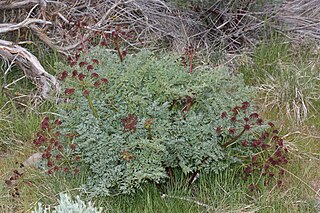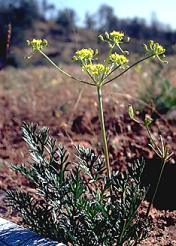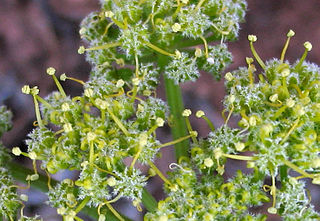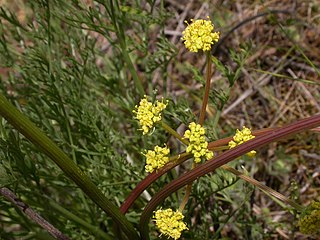
Lomatium is a genus of about 75 species of perennial herbs native to western North America; its common names include biscuitroot, Indian parsley, and desert parsley. It is in the family Apiaceae and therefore related to many familiar edible species such as carrots and celery; some Lomatium species are extensively used by Native Americans in the inland Northwest as a staple food.

Lomatium dissectum is a species of flowering plant in the carrot family known by the common names fernleaf biscuitroot and fernleaf desert parsley. It is native to much of western North America, where it grows in varied habitat. It is found in the eastern slopes of the Cascade Range, Rocky Mountains, Klamath Mountains, eastern Transverse Ranges and the Sierra Nevada in California.

Lomatium utriculatum is a species of flowering plant in the carrot family known by the common name common lomatium or spring gold. It is native to western North America from British Columbia to California, where it grows in many types of habitat including chaparral, and in the Sierra Nevada.

Vaccinium parvifolium, the red huckleberry, is a species of Vaccinium native to western North America, where it is common in forests from southeastern Alaska and British Columbia south through western Washington and Oregon to central California.

Eriogonum parvifolium is a species in the family Polygonaceae that occurs on dune formations in the coastal area of Central and Southern California. This evergreen shrub grows to a height of 30 to 100 centimeters with a spread of approximately the same dimension. This plant is an important host for a number of pollinating insects including certain endangered species. E. parvifolium occurs both on bluffs along the Pacific Ocean coast as well as Coastal Strand dunes formations, but is restricted to altitudes below 700 meters. In at least one instance within the Carbonera Creek watershed, it occurs farther inland in a Maritime Coast Range Ponderosa Pine forest. This shrub is also known by the common names dune buckwheat, coast buckwheat, cliff buckwheat, or seacliff buckwheat.

Vaccinium ovatum is a North American species of flowering shrub known by the common names evergreen huckleberry,winter huckleberry and California huckleberry.

Lomatium congdonii, known by the common names Mariposa desertparsley and Congdon's lomatium, is a species of flowering plant in the carrot family.

Lomatium foeniculaceum is a species of flowering plant in the carrot family known by the common name desert biscuitroot. It is native to much of western and central North America, where it grows in many types of habitat.

Huckleberry is a name used in North America for several plants in the family Ericaceae, in two closely related genera: Vaccinium and Gaylussacia. The huckleberry is the state fruit of Idaho.

Lomatium caruifolium, known by the common name alkali desertparsley, is a species of flowering plant in the carrot family.

Lomatium dasycarpum is a species of flowering plant in the carrot family known by the common name woollyfruit desertparsley. It is native to California and Baja California, where it is widespread throughout many of the mountain ranges, including the Peninsular, Sierra Nevada, and California Coast Ranges, and in valleys.

Lomatium howellii is an uncommon species of flowering plant in the carrot family known by the common name Howell's biscuitroot, or Howell's lomatium. It is native to the Klamath Mountains of southern Oregon and northern California, where it is a member of the local serpentine soils flora.
Lomatium marginatum is a species of flowering plant in the carrot family known by the common name butte desertparsley. It is endemic to California, where it is known from mountains, valley, and grassland habitat, including serpentine, in the northern half of the state. It is a perennial herb growing up to about half a meter tall from a small taproot. There is no stem, and the leaves and inflorescence emerge from ground level. The purple-green leaves may approach 30 centimeters long, their blades divided into many long, narrow segments. The short but wide inflorescence bears an umbel of yellowish, purplish, or reddish flowers. The Lomatium marginatum is not currently an endangered species.

Lomatium martindalei is a species of flowering plant in the carrot family known by the common names Cascade desertparsley and coast range lomatium. It is native to the west coast of North America, from Vancouver Island south to the Klamath Mountains of far northern California. It can be found in a number of coastal and inland habitats, from coastal plains to high mountain talus and meadows. This is a perennial herb growing 15 to 40 centimeters tall from a carrot-like taproot. There is often no stem, the erect or spreading leaves and inflorescence emerging from ground level. The thinly fleshy leaves may approach 20 centimeters long, their blades divided into leaflets made up of many small oval segments. The inflorescence bears an umbel of small yellowish flowers.
Lomatium ravenii is a species of flowering plant in the carrot family known by the common names Lassen parsley and Raven's lomatium. It is native to the Great Basin of the United States, where it grows in sagebrush and other plateau habitat, including areas with somewhat alkaline soils in Nevada, California, and other states.
Lomatium repostum is an uncommon species of flowering plant in the carrot family known by the common name Napa biscuitroot, or Napa lomatium. It is endemic to California, where it is known only from the northrthern California Coast Ranges surrounding the northern San Francisco Bay Area. It often grows in plant communities on serpentine soils.
Lomatium shevockii is a rare species of flowering plant in the carrot family known by the common name Owens Peak desertparsley, or Owens Peak lomatium. It is endemic to Kern County, California, where it is known from only two occurrences at Owens Peak, one of the highest points of the Sierra Nevada. It is a plant of the talus and wooded slopes of the high mountains. This species was discovered in 1984 and first described to science in 1988.

Lomatium stebbinsii, known by the common name Stebbins' desertparsley, is a rare species of flowering plant in the carrot family.

Lomatium cookii is a rare species of flowering plant in the carrot family known by the common names Cook's lomatium and agate desertparsley. It is endemic to Oregon in the United States, where it grows in only two valleys. It is a federally listed endangered species.

Leptospermum parvifolium, commonly known as lemon-scented tea-tree, is a species of shrub that is endemic to eastern Australia. It has thin, rough bark, egg-shaped leaves with the narrower end towards the base, white or pink flowers, and fruit with the remains of the sepals attached but that is shed when the seeds are mature.















